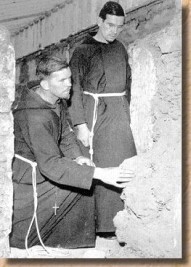
Upon arriving at Mission Santa Inés in 1924, the Capuchin Franciscans installed electricity and modern plumbing to improve the living conditions. The inner garden was given a formal appearance in 1926 with the planting of a hedge in the shape of a Celtic cross and installation of a fountain.
 |
The expansive garden behind the Mission is a lovely surprise for many visitors. Dating to the Mission's earliest days, the garden has undergone many changes; it currently retains the formal design of a hedge in the shape of a Celtic cross implemented by the Capuchin Franciscans in 1926. |
 |
| Fathers Kelleher and O'Leary examine adobe walls during renovation work in 1949. SANTA INÉS MISSION ARCHIVE. |
Full restoration of the Mission began in 1947. When the workman removed the roof from part of the residence, they discovered the outline of several rooms above the arches that had been used by during the Mission Era. The second story was added making the Mission look as it did before the earthquake of 1812. Extensive repairs were made to the roof of the church and residence, and sections of the south end of the building were completely remodeled.
Additionally, the bell tower was remodeled to conform to its original design as confirmed by artwork and photographs prior to its collapse in 1911. Red tile flooring unearthed during the project affirmed that the Mission edifice originally has 22 arches not 21 as previously believed. A Mission bell was shipped from Rotterdam (the Netherlands) for recasting and returned in time to ring out in celebration of the 150th anniversary of Mission Santa Inés in 1954.
The Chapel of the Madonna was created during this period and numerous restoration projects were initiated. A radiation heating system was installed in the church under the original restored tile floor to preserve the Mission's priceless paintings and other artwork. The entire Mission was painted and weatherproofed. Improved irrigation and drainage systems were installed for the various refurbished and landscaped gardens. In 1954 a statue of Our Lady of Lourdes made in Obergammergau (Bavaria, Germany) was installed in a shrine next to the cemetery.
 |
| The restored arched colonnade with ruin of the original 19th arch. |
Two new bronze bells named "Santa Inés" and "Saint Frances" were cast and installed in the bell tower in 1984. In August of 1989 the 18th annual Fiesta celebrated many years of hard work - in particular the million-dollar renovation and restoration project of the east wing. Key to this project was the reconstruction of eight of the 19 arches that form the eastern façade of the building. This restoration recreated the appearance and almost the original length of the east wing or convento prior to the Secularization in 1834. All that remained was the 19th of the 22 arches. It was decided to keep this original arch standing both as a reminder of the original building as well as of the neglect and abuse that the missions suffered under secularization. The new portion of the convento building now houses a large parish hall complete with kitchen and two conference rooms. All are used by the parish as well as area groups for meetings. Inside the hall are several large paintings done by local artists depicting the various eras of mission life as well as the present life of the parish. Restoration efforts of the Mission paintings became the focus in 1992 and are ongoing.

